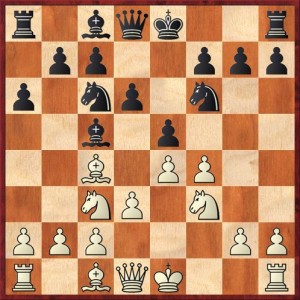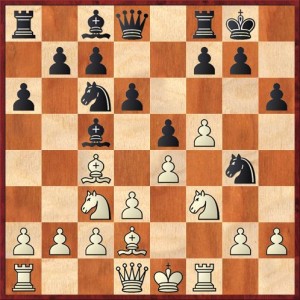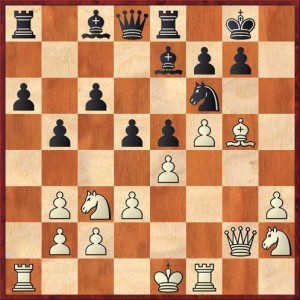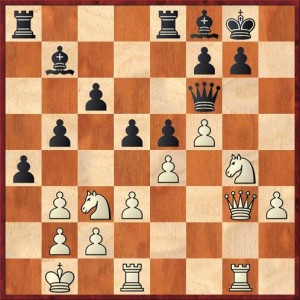A couple weeks ago Francisco Anchondo asked me to write a post about our game from the last round of the Larry Evans Memorial (which we played in March). We’ve played two games now and I’ve won them both, but not without a few close calls and moments of panic. I enjoy playing against Francisco because his style is in some ways a mirror of mine; he always fights for the initiative and is not averse to sacrificing material to get it.
In our first game I played 1. d4 and he answered with the Albin Counter Gambit. So this time I decided to start with 1. e4, and he replied with 1. … e5 2. f4 Bc5, the classical variation of the King’s Gambit Declined.
After the game Francisco told me that he had never lost a game before in this variation. It’s probably a good choice for a gambiteer. He doesn’t want to accept my gambit because psychologically he will be on the wrong side of the position. And in fact he offered a pawn himself almost as soon as possible, with 3. Nf3 d6 4. Nc3 a6. Here I could play 5. fe de 6. Nxe5, but after 6. … Qd4 7. Nd3 he’s the one having fun, not me. (Plus, I don’t know anything about this variation.) So I declined his gambit for exactly the same reason he declined mine. After 5. Bc4 Nf6 6. d3 Nc6 we are back in the main variation.
I’ve just started playing the 4. Nc3 variation again after about 15 years of playing 4. c3. So I’m not exactly sure what I’m doing yet. Here I played 7. Rf1 because I saw this move in a book back around 1995 and liked it. It’s a “zebra chess” move, waiting for Black to give me more information. If Black plays 7. … Bg4, then I can play the exchange sac 8. h3 Bxf3 9. Qxf3 Nd4 10. Qg3! and it’s better than usual because of the rook already being developed. Or if Black castles, White has the advantage of knowing where Black’s king is going to be.
That is, in fact, what happened: 7. … O-O 8. f5 h6?! The punctuation is from Thomas Johansson’s book, The Fascinating King’s Gambit, which is a must-own for all King’s Gambit players. He says that 9. Nd5! is “more or less a refutation of the whole line,” and that Black should have gotten the jump on White with 8. … Nd4 instead.
Unfortunately, owning the book does not mean I’ve read the book, so I didn’t know any of this. I played the lame 9. Bd2?!, one of those moves that is so bad that it’s good! In this game, it gave my opponent an incentive to play 9. … Ng4?!, a move that is extremely clever but probably premature.
Here I spent 36 minutes (!!) deciding on my next move. After the obvious 10. h3 Nh2! 11. Nxh2 Qh4+ 12. Ke2 Nd4+ White is just dead. The only move that I could find that avoided a debacle was 10. g3, but the funny thing is, it’s a good move! If Black plays the obvious 10. … Ne3 11. Bxe3 Bxe3, then 12. Nd5 poses a dilemma. If 12. … Bg5 13. h4 Be7 Black has managed to imprison his own bishop. If 12. … Ba7 13. f6! Bh3 14. Nh4! is great. But if Black doesn’t play 10. … Ne3, what was the point of playing … Ng4 to begin with?
Moral: 9. … Ng4 was cute but had to be avoided.
The game continued 10. … Na5 11. Qe2 b5 12. Be3 Nxb3 13. ab c6 14. h3 Nf6 15. g4 d5 16. g5?! I think this may have been a mistake. I thought that it was safer to keep my king in the center than castle, but I forgot the principle that you want to finish developing before you launch an attack. You don’t want to discover halfway through the attack that you need reinforcements and can’t get them into action in time.
After 16. … hg 17. Bxg5 Re8 18. Nh2 Be7 19. Qg2 Black could have taken advantage of the fact that I left my king in the center too long. Can you see how?
A good start is 19. … de, because after 20. d3 White now can no longer castle. However, it’s even better if you start out first with 19. … b4! First of all, this undermines the e-pawn. It also sets a diabolical trap: If 20. Ne2 (a very plausible-looking move) now 20. … de 21. de Nxe4! wins a pawn. The main point is 22. Bxe7?? Qd2 mate! Or 22. Bh6 Bh4+!, forcing White to interpose a piece and lose material. The basic problem for White is that his control over the dark squares is collapsing, and his king is caught in the crossfire. A drastic punishment for failing to castle in time!
So White instead has to play 20. Nd1 or 20. Na4, but I think that Black has a very pleasant advantage after 20. Nd1 de 21. d3 Qd4. To keep from losing the e-pawn White may have to play 22. Bxf6 Bxf6, but now once again the dark squares are turning into a terrible weakness.
I think there is a lot to be learned from the difference between 10. … Ng4? and 19. … b4! Roman Dzindzichashvili called these “good” and “bad” traps in one of his few ChessLectures. A good trap is one that improves your position even if your opponent doesn’t fall into it. After 19. … b4, either White falls into the trap or else he has to move his knight to an inferior square. Either way, Black has gained something. By contrast, after 10. … Ng4, either White falls into the trap… or he doesn’t, and Black hasn’t gained anything. In fact, Black lost a tempo by having his knight chased back to f6.
Instead of 19. …. b4, Black played 19. … Bb7? You’d think that such an obvious developing move could not possibly be wrong. But it is! It’s all about needs and opportunities. Black had to realize, first of all, that he needs to seize the initiative away from White. If White is given the time to build up his forces on the g-file, then Black’s position will become critical. Second, Black had to realize that he has the opportunity to seize the initiative, by taking advantage of White’s awkwardly placed king.
Sometimes in chess, you have the need but the opportunity doesn’t exist. Other times you have an opportunity but the need doesn’t exist. In those cases you can and probably should bide your time and wait for either the need or the opportunity to mature. But when you have both the need and the opportunity to strike, then patience is no longer a virtue!
I replied with 20. Rg1 and Francisco played 20. … Qd6. Now I had the opportunity to play 21. Bh6, but not the need. I was very uncertain whether I actually had the advantage after 21. Bh6 Nh5 22. Bxg7 Bh4+! 23. Kd2 Bg3. At any rate, it looks risky for both sides.
Instead I simply played 21. O-O-O, figuring that I could postpone Bh6 until the time was ripe. This is a case where patience was a virtue. I felt that I could get just as strong an attack with much less risk by getting my king out of the center. Francisco played 21. … Bf8, a logical move shoring up his weak point on g7.
At this point both of us were getting pretty low on time. I had about 20 minutes left for 19 moves, and he had about 15 minutes. This made me feel pretty good about my chances, because I’m used to being behind on time. Not only that, I was able to find a good plan here. I realized that Bxf6 followed by Ng4 would be a very strong sequence of moves except for the fact that Black can answer them with … Qg5+. So I spent two tempi methodically removing that threat: 22. Kb1! a5 23. Qg3! I really don’t think Francisco had any idea what I was trying to accomplish with these two moves; they look very unthreatening. As far as he could tell, I was just dilly-dallying around, and true to his style he continued in aggressive fashion with 23. … a4.
And now is the moment when need and opportunity lock into focus. The need is urgent; if I give Black any more time he will play … a3 and … ab and I will be busted. But the opportunity is there, not to play Bh6 but to play 24. Bxf6! Qxf6 25. Ng4!, and now where can Black put his queen?
Probably the most dangerous move is 25. … Qd6, but White’s attack breaks through just a tempo before Black’s. After 26. f6! a3 27. Nh6+! is curtains, and likewise after 26. f6! g6 27. Qh4 a3 28. Nh6+ Bxh6 29. Qxh6 Qf8 30. Rxg6+!
Now I have to admit that I did not see all of this during the game. I just sensed it. In fact, I didn’t realize until I analyzed the game today just how close this whole plan came to not working. (My analysis during the game was more like, “If he plays 25. … Qd6 I must be winning after 26. f6.”)
Instead Francisco played the move I expected, the move a human chess player in time trouble is almost certain to make: 25. … Qg5. Again, his thinking was probably very simple: “I’ve got to trade queens or else I will be mated.” And in fact, that thinking was exactly correct. But it cost him the exchange and a pawn, after 26. h4! (the point of 23. Qg3) Qf4 27. Nf6+ Kh8 28. Nxe8 Qxg3 29. Rxg3 Rxe8 30. ba. The rest was very easy.
Francisco, thanks for the great game, and also thanks for encouraging me to write about it. For the rest of you, I hope it has given you some food for thought!







{ 1 comment… read it below or add one }
Here are some comments on a possible defensive idea for black (totally unoriginal, since I just happened to see the same recently). This actually reminds me – in a peripheral way (since the position is not exactly similar, after the h pawn goes) of the king’s flight defense games from Nimzo’s Chess Praxis. As a matter of fact, Nimzo had also pushed the pawn to h6 – I’ve tried to throw some light on this game on chessgames.com (http://www.chessgames.com/perl/chessgame?gid=1102332&kpage=1#reply7).
The circumstance of the black pawn being on h6 is immediately suggestive of a future pawn storm to g5 – I think that this is something that must just leap into one’s consciousness. Agaard calls these ‘hooks’ in his positional treatise. Moving the knight to g4 therefore seems to invite this pawn storm, regardless of immediate goals. Nimzo’s plan in his game was to await matters, so see whether white was going to attack with the pawns or the pieces, the point being that the pawn storm would deny the white pieces of squares.
I don’t see why that very same plan won’t work in this game.
1. Push the KN to h7.
2. Play f6
3. Wait
4. Move the KN to g5 pursuant to white doing pawn or piece attack.
But most importantly, in Nimzo’s game, he gives the black king a flight square by playing f6 and Kf7. In the current game, we could implement that by eliminating the bishop (which, as we know, should be one of the first things to eliminate anyway, since it is the attacking Bishop) by playing Na5 on move 9 instead of Ng4.
This game’s finish is quite aesthetic!
{ 1 trackback }